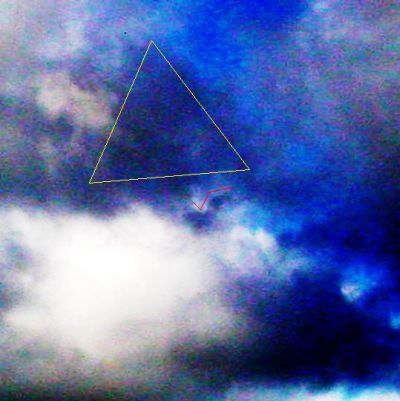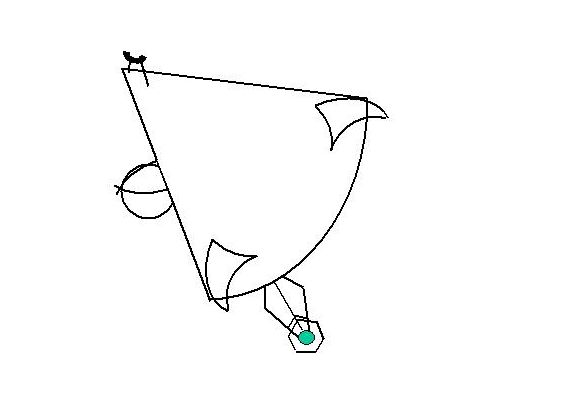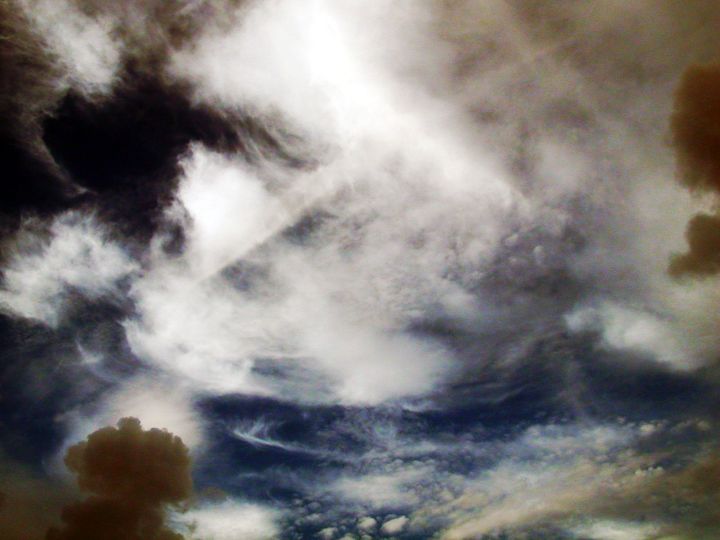UFOs in the clouds
William C. Treurniet, Jan/Feb, 2008
Summary. A photograph taken in Ottawa, Canada, appears to show a large physical object partially hidden behind cloud material. An apparently artificial solid object projects below the cloud layer, and an outline of a 60-degree sector of a circle appears in the clouds beside it. The sector has internal structure and is estimated to be about 277 m across at its widest point. Another six photos taken on the Hawaiian islands each showed evidence of a similar triangular object partially hidden in the clouds. Two of the objects were also accompanied by seemingly artificial components extending below the clouds. The seven objects were tentatively divided into three classes based on size. The average triangle edge lengths for the three classes were 60 m, 134 m, and 413 m. The lengths ranged from 52 m to 550 m. The triangular objects were interpreted as novel spacecraft barely hidden behind the cloud layer. Introduction
Recent photographs of the sky show geometrical objects that are not completely covered by clouds and seem to be machines. Their similar properties suggest that they are constructed and their appearance is not due to some chance organization of cloud material. Specifically, most have the equilateral triangle or sector shape. For the remainder, the equilateral shape may be masked by an orientation not parallel to the frontal plane of the camera. All have tori positioned at vertices and elsewhere. In several cases, components possibly attached to the objects were visible below the cloud layer.Seven individual cases are described in this document. If you like, go directly to any one of them.
Case 1: Ottawa
Case 2: Honolulu
Case 3: Kauai
Case 4: Maui
Case 5: Kauai
Case 6: Honolulu
Case 7: Kauai
The idea that spacecraft may be hidden behind cloud material was also suggested in earlier reports. Please see 2007a and 2007b for specific cases where a possible UFO camouflaged by cloud cover appeared to affect its environment. Also see a report by Ann Druffel on UFO activity originating in anomalous clouds off the southern coast of California beginning in 1962.
Case 1
A photograph taken on October 25, 2007, near Ottawa International Airport, Ottawa, Canada, shows several objects in the clouds that are thought to be artificial primarily because of their geometry. The images in this section were cropped from the original photo. The following image shows the most obvious anomaly, an apparently solid object projecting below the cloud. It's shape appears to represent the three orthogonal directions in space. This axis object, which models the abstract concept of frame-of-reference, is most likely a constructed object. |
 |  |
 |  |
It is possible to estimate the size of the spacecraft given the properties of the camera as well as knowledge of the cloud altitude on the day the picture was taken. From information available at the Weather Underground, we know that the cloud altitude on October 25, 2007, was approximately 2500 ft. One side of the spacecraft in the original picture was about .33 of the overall picture width. The empirically determined field of view of the camera is about 60 degrees, so we can say that the object subtended an angle of about 19.8 degrees (.33 x 60 degrees). Given a distance of 2500 feet from the camera to the cloud, the spacecraft must have been about 900 ft across at its widest point, or 277 m.
Case 2
This photograph showing similar objects in the clouds was taken on Waikiki Beach in Honolulu on October 12, 2007, sometime in the afternoon. Details in this photo are easier to see when the contrast is increased by equalization. The equalized image shows the presence of several equilateral triangle shapes in the clouds.The following image on the left is a crop of the most interesting triangle and its immediate environment. The middle image shows the same information but with the contrast enhanced. The right image is marked with lines to emphasize the objects of interest. There we see the equilateral triangle similar to the sector shape in the Ottawa photo. Then there is the intriguing, apparently solid object beside the triangle. The shape is a bit different from the axis object in the Ottawa photo, but it still appears to represent the three dimensions in space. That is, the object also models the abstract concept of frame-of-reference, and we can call it an axis object as well. There appears to be a torus near each of the lower two vertices, and a number of other tori are scattered on and around the object as in Case 1.
 |  |  |
Case 3
This photograph taken on the island of Kauai in the mid-afternoon of October 15, 2007, contains an object at the edge of a cloud that appears to be a triangular craft of some kind. The following cropped image shows that the end we can see has an exact 60 degree angle. There is a hint of an arc between the ends of the lines marking this angle in the right image, so the object may have the sector shape seen in Case 1. Because of the thickness of the cloud cover, we cannot be sure. The axis object, however, is not visible. Rather, it appears to have been replaced with a complex of tori. Note that the vertex of the triangle is centered exactly on a torus outlined in the right image. Recall that the center of the circle in Case 1 was also marked by a torus. |  |  |
Case 4
This photograph taken on the island of Maui in the late afternoon of October 18, 2007, contains an object very similar to the triangular object of Case 3. The following cropped image shows that the vertex is again exactly 60 degrees. This time the arc joining the lines is more obvious and it is outlined as well in the right image. It seems clear that this object has the sector shape seen in Case 1. As in Case 1 and Case 3, the vertex of the sector is aligned with the center of a torus. |  |  |
Case 5
This photograph was taken on the island of Kauai in the mid-morning of October 17, 2007. As in the previous cases, the following cropped image shows an equilateral triangle or sector shape in the cloud. A torus is prominently positioned near one vertex as shown with yellow graphics in the right-hand image. As in Case 1, the side opposite this vertex seems to be exuding a stream of tori. Another similarity to Case 1 is the faint ribbed pattern emphasized by the red lines in the interior of the triangle. Click on the center and right images to see larger versions. |  |
The left image below shows three intersecting rings partly occluded by the main object and the surrounding cloud material. These rings are positioned approximately at the middle of the triangle edge.
The middle image below shows two or three long extensions leading from the main object to a partly visible hexagonal structure. The long extensions appear to be connected to an additional structure at the center of the hexagon.
The right image below shows a cupped, triangular structure at the upper-right vertex of the main object. The surface is textured with tori of different sizes and orientations. Although it is more obscured by cloud material, a similar structure is recognizable at the lower left vertex in the image above. One could speculate that the object is some kind of craft and that these structures are landing pads. If so, there would need to be a support for the craft at the remaining upper-left vertex. In fact, an object suitable for this purpose extends through the center of the torus at that vertex.
 |  |  |
 |
Case 6
This photograph was taken on Waikiki Beach in Honolulu in the afternoon of October 12, 2007, the same afternoon as the photo of Case 2. The following image shows a well-defined triangle vertex extending from the cloud as in Cases 3 and 4. If an equilateral triangle were tilted away from the frontal plane by about 60 degrees, its projection would be approximately as shown. Also as in the previous cases, a torus is positioned on the vertex. From the curved side opposite this vertex, there seems to be a stream of tori demarcated by the red lines in the right-hand image. Again, there is faint ribbed pattern marked by the red lines in the interior of the triangle. |  |  |
Case 7
This photograph was taken on the island of Kauai in the late afternoon of October 16, 2007. The image shows what seems to be a triangle object partially hidden in the cloud. The most obvious edge is clearly defined by a thin layer of cloud material streaming across it. Another edge is inferred from the bright linear band of cloud material in the right of the image just above the material shaped like a cluster of tori. The location of the bottom edge is estimated simply by joining these two sides. If the triangle were equilateral and if it were tilted away from the frontal plane by about 45 degrees, its projection would be approximately as shown. Consistent with the other cases, the vertex on the left is approximately aligned with the center of a torus. |  |  |
Conclusion
These cases offer compelling evidence that constructed objects may be found hidden among the clouds. The objects appear to have the shape of either an equilateral triangle or a circle sector with a 60-degree vertex. The bottom of the object sometimes has a ribbed structure, one vertex is always closely associated with a torus, and the edge opposite this vertex is usually associated with a mass of tori extending away from the object. In three cases, one or more apparently solid extensions from the object were visible just below the cloud layer. An obvious interpretation of these objects is that they are novel spacecraft with the ability to float among the clouds.The objects seem to vary in size as summarized in Table 1. Accepting some measurement error, three classes based on the length of the triangle edges are suggested; Class 1 (Case 3, Case 4), Class 2 (Case 2, Case 5, Case 6), and Class 3 (Case 1, Case 7). The mean lengths for these classes are 60 m, 134 m, and 413 m, and the lengths range from 52 to 550 m. These measurements indicate that different classes of spacecraft were captured in the photographs.
| Case # | Estimated size (m) |
|---|---|
| 1 | 277 |
| 2 | 97 |
| 3 | 52 |
| 4 | 67 |
| 5 | 150 |
| 6 | 156 |
| 7 | 550 |


No comments:
Post a Comment